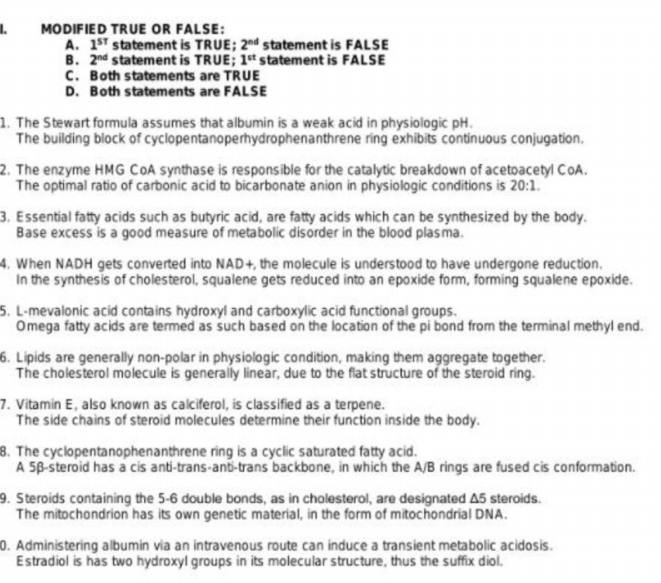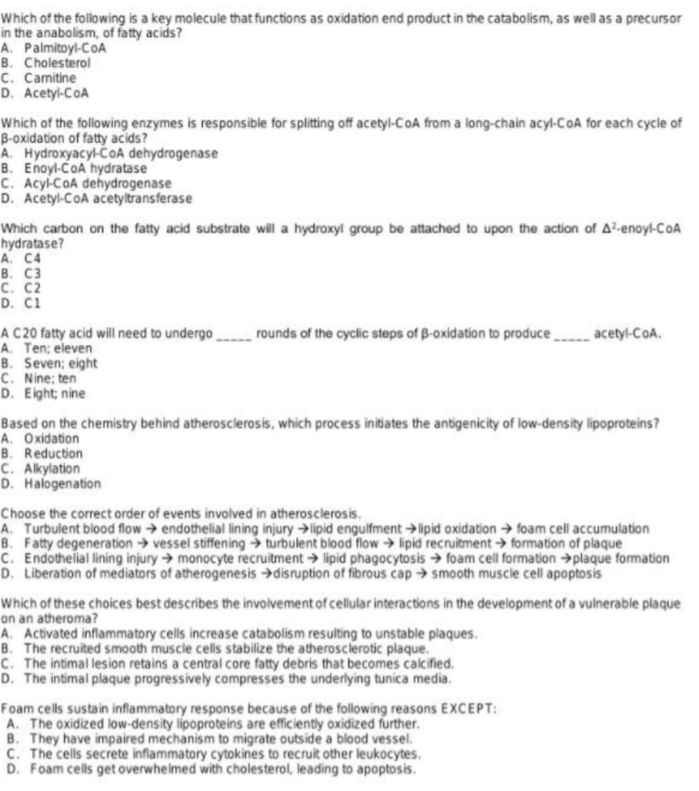Which of the following is a key molecule that functions as oxidation end product in the catabolism, as well as a precursor in the anabolism, of fatty acids? A. Palmitoyl-CoA IB. Cholesterol C. Camitine D. Acetyl-CoA Which of the following enzymes is responsible for splitting off acetyl-CoA from a long-chain acyl-CoA for each cycle of B-oxidation of fatty acids? A. Hydroxyacyl-CoA dehydrogenase IB. Enoyl-COA hydratase C. Acyi-CoA dehydrogenase D. Acetyl-CoA acetyltransferase Which carbon on the fatty acid substrate will a hydroxyl group be attached to upon the action of A-enoyl-CoA thydratase? A. C4 B. C3 c. C2 ID. C1 A C20 fatty acid will need to undergo A. Ten; eleven B. Seven; eight c. Nine; ten ID. Eight; nine rounds of the cyclic steps of B-oxidation to produce acetyl-CoA.
Which of the following is a key molecule that functions as oxidation end product in the catabolism, as well as a precursor in the anabolism, of fatty acids? A. Palmitoyl-CoA IB. Cholesterol C. Camitine D. Acetyl-CoA Which of the following enzymes is responsible for splitting off acetyl-CoA from a long-chain acyl-CoA for each cycle of B-oxidation of fatty acids? A. Hydroxyacyl-CoA dehydrogenase IB. Enoyl-COA hydratase C. Acyi-CoA dehydrogenase D. Acetyl-CoA acetyltransferase Which carbon on the fatty acid substrate will a hydroxyl group be attached to upon the action of A-enoyl-CoA thydratase? A. C4 B. C3 c. C2 ID. C1 A C20 fatty acid will need to undergo A. Ten; eleven B. Seven; eight c. Nine; ten ID. Eight; nine rounds of the cyclic steps of B-oxidation to produce acetyl-CoA.
Biochemistry
6th Edition
ISBN:9781305577206
Author:Reginald H. Garrett, Charles M. Grisham
Publisher:Reginald H. Garrett, Charles M. Grisham
Chapter19: The Tricarboxylic Acid Cycle
Section: Chapter Questions
Problem 18P
Related questions
Question
hello help me answer this

Transcribed Image Text:MODIFIED TRUE OR FALSE:
A. 1ST statement is TRUE; 2nd statement is FALSE
B. 2nd statement is TRUE; 1t statement is FALSE
C. Both statements are TRUE
D. Both statements are FALSE
1. The Stewart formula assumes that albumin is a weak acid in physiologic pH.
The building block of cyclopentanoperhydrophenanthrene ring exhibits continuous conjugation.
2. The enzyme HMG COA synthase is responsible for the catalytic breakdown of acetoacetyl CoA.
The optimal ratio of carbonic acid to bicarbonate anion in physiologic conditions is 20:1.
3. Essential fatty acids such as butyric acid, are fatty acids which can be synthesized by the body.
Base excess is a good measure of metabolic disorder in the blood plasma.
4. When NADH gets converted into NAD+, the molecule is understood to have undergone reduction.
In the synthesis of cholesterol, squalene gets reduced into an epoxide form, forming squalene epoxide.
5. L-mevalonic acid contains hydroxyl and carboxylic acid functional groups.
Omega fatty acids are termed as such based on the location of the pi bond from the terminal methyl end.
6. Lipids are generally non-polar in physiologic condition, making them aggregate together.
The cholesterol molecule is generally linear, due to the flat structure of the steroid ring.
7. Vitamin E, also known as calciferol, is classified as a terpene.
The side chains of steroid molecules determine their function inside the body.
8. The cyclopentanophenanthrene ring is a cyclic saturated fatty acid.
A 58-steroid has a cis anti-trans-anb-trans backbone, in which the A/B rings are fused cis conformation.
9. Steroids containing the 5-6 double bonds, as in cholesterol, are designated A5 steroids.
The mitochondrion has its own genetic material, in the form of mitochondrial DNA.
0. Administering albumin via an intravenous route can induce a transient metabolic acidosis.
Estradiol is has two hydroxyl groups in its molecular structure, thus the suffix diol.

Transcribed Image Text:Which of the following is a key molecule that functions as oxidation end product in the catabolism, as well as a precursor
in the anabolism, of fatty acids?
A. Palmitoyl-CoA
B. Cholesterol
C. Camitine
D. Acetyl-CoA
Which of the following enzymes is responsible for splitting off acetyl-CoA from a long-chain acyl-CoA for each cycle of
B-oxidation of fatty acids?
A. Hydroxyacyl-CčOA dehydrogenase
B. Enoyl-CoA hydratase
C. Acyl-CoA dehydrogenase
D. Acetyl-CoA acetyltransferase
Which carbon on the fatty acid substrate will a hydroxyl group be attached to upon the action of A²-enoyl-CoA
hydratase?
A. C4
в. СЗ
с. С2
D. Ci
A C20 fatty acid will need to undergo
A. Ten; eleven
B. Seven; eight
C. Nine; ten
D. Eight; nine
rounds of the cyclic steps of B-oxidation to produce acetyl-CoA.
Based on the chemistry behind atherosclerosis, which process initiates the antigenicity of low-density lipoproteins?
A. Oxidation
B. Reduction
C. Alkylation
D. Halogenation
Choose the correct order of events involved in atherosclerosis.
A. Turbulent blood flow → endothelial lining injury →lipid engulfment →lipid oxidation → foam cell accumulation
B. Fatty degeneration → vessel stiffening → turbulent blood flow → lipid recruitment → formation of plaque
C. Endothelial lining injury → monocyte recruitment → lipid phagocytosis → foam cell formation →plaque formation
D. Liberation of mediators of atherogenesis →disruption of fibrous cap → smooth muscle cell apoptosis
Which of these choices best describes the involvement of cellular interactions in the development of a vulnerable plaque
on an atheroma?
A. Activated inflammatory cells increase catabolism resulting to unstable plaques.
B. The recruited smooth muscle cells stabilize the atherosclerotic plaque.
C. The intimal lesion retains a central core fatty debris that becomes calcified.
D. The intimal plaque progressively compresses the underlying tunica media.
Foam cells sustain inflammatory response because of the following reasons EXCEPT:
A. The oxidized low-density lipoproteins are efficiently oxidized further.
B. They have impaired mechanism to migrate outside a blood vessel.
C. The cells secrete inflammatory cytokines to recruit other leukocytes.
D. Foam cells get overwhelmed with cholesterol, leading to apoptosis.
Expert Solution
This question has been solved!
Explore an expertly crafted, step-by-step solution for a thorough understanding of key concepts.
This is a popular solution!
Trending now
This is a popular solution!
Step by step
Solved in 2 steps

Recommended textbooks for you

Biochemistry
Biochemistry
ISBN:
9781305577206
Author:
Reginald H. Garrett, Charles M. Grisham
Publisher:
Cengage Learning

Biology: The Dynamic Science (MindTap Course List)
Biology
ISBN:
9781305389892
Author:
Peter J. Russell, Paul E. Hertz, Beverly McMillan
Publisher:
Cengage Learning

Anatomy & Physiology
Biology
ISBN:
9781938168130
Author:
Kelly A. Young, James A. Wise, Peter DeSaix, Dean H. Kruse, Brandon Poe, Eddie Johnson, Jody E. Johnson, Oksana Korol, J. Gordon Betts, Mark Womble
Publisher:
OpenStax College

Biochemistry
Biochemistry
ISBN:
9781305577206
Author:
Reginald H. Garrett, Charles M. Grisham
Publisher:
Cengage Learning

Biology: The Dynamic Science (MindTap Course List)
Biology
ISBN:
9781305389892
Author:
Peter J. Russell, Paul E. Hertz, Beverly McMillan
Publisher:
Cengage Learning

Anatomy & Physiology
Biology
ISBN:
9781938168130
Author:
Kelly A. Young, James A. Wise, Peter DeSaix, Dean H. Kruse, Brandon Poe, Eddie Johnson, Jody E. Johnson, Oksana Korol, J. Gordon Betts, Mark Womble
Publisher:
OpenStax College

Biology 2e
Biology
ISBN:
9781947172517
Author:
Matthew Douglas, Jung Choi, Mary Ann Clark
Publisher:
OpenStax
